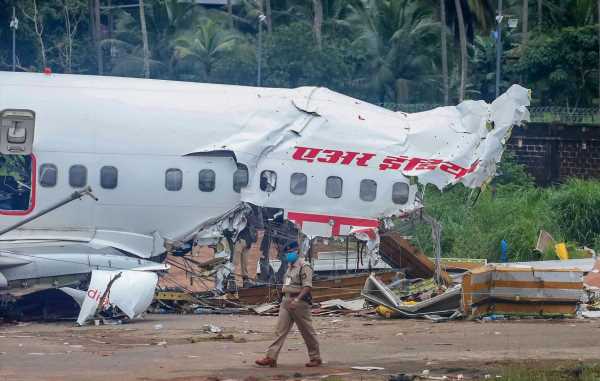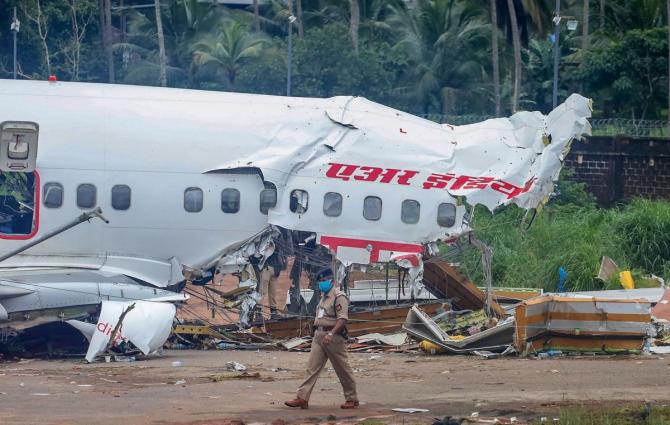Serving pilots question the Kozhikode plane crash report findings.
The much delayed final investigation report of the Kozhikode air crash has squarely blamed the pilots – former Indian Air Force commander Deepak Sathe and his first officer Akhilesh Kumar — for the fatal crash in August 2020 that killed 21 people including both pilots.
Serving pilots have raised serious doubts over the findings of the report released in September.
The report says the 59-year-old Sathe, a diabetic, took medications that induced hypoglycaemia (a drastic drop in blood sugar), which distorted his decision-making abilities, leading to the crash. The report states he was “taking tablet Glimepiride, which has a very high potential to cause hypoglycaemia when consumed along with other anti-diabetic drugs”.
Investigators had found four common diabetic medicines — Metformin, Pioglitazone, Glimepiride, and Dapagliflozin — and an Ayurvedic formulation during a post-crash search of Sathe’s hotel room. His blood samples collected after the crash revealed the presence of the first two drugs. Diabetic pilots are not prohibited from taking these medicines.
Captain Sonia Chatterjee*, a serving airline pilot, said, “He could have kept Glimepiride and others so that he could have had them after the flight. He was nailed in the report for just keeping those medicines.”
RV Jayakumar, director of Indian Institute of Diabetes, Thiruvananthapuram, added that, “Metformin and Pioglitazone are not powerful drugs that are capable of inducing hypoglycaemia. Even when taken together they rarely, if ever, induce low blood sugar.”
The probe also indicates that Sathe has been fasting for five hours while landing at Kozhikode, which could have led to “blurry vision and mental disorientation”.
Sathe’s post-mortem revealed undigested food in the intestine, but there was no examination of when that food was consumed. Sathe only ate specially prepared “bland meals” in-flight and in his hotel and had consumed nothing from the plane’s snack box.
The report does not mention whether the cabin crew was quizzed about Sathe’s food consumption on board. He was only reported to have had a cup of sugarless black coffee during the four-hour flight.
Jayakumar said, “A rare combination of not having food for a long time, his age and drug combinations were capable of inducing low blood sugar. But it is hard to believe that a long-time diabetic would have made that choice.”
Even more intriguing were the failures of crucial aircraft equipment — two of which were critical for landing in heavy rains. The city was experiencing well over 200 millimetres of rain every day. Moments before he aborted his first landing, Sathe was recorded as saying: “Isko kya ho gaya (what happened to this)?…Oh s**t…wiper is gone…(sound of laughter) what a day for the wiper to go (sound of more laughter)….”
“In that kind of rain, not having wipers is like landing with both eyes closed,” said Capt Raza Farooqui*, a serving airline pilot.
The probe report questioned Sathe’s motives in not diverting the flight to Coimbatore where there was no rain. The plane had enough fuel to divert even after hovering for a long time over Kozhikode.
“It is easier said than done. Kozhikode has a black hole approach where there are no visible lights until you are really close to the airport. Add to that the blinding rain, sub-optimally functioning wipers and a host of other calculations that needed to be made, the pilot ideally would have a tunnel vision where the focus is solely on landing safely at the designated airport. At best he could have landed on autopilot,” said Capt Farooqui*.
The report mentions that the instrument that records pressure in the right brake had been displaying “illogical” readings ever since it was installed in 2018 after cannibalising it from another Air India Express aircraft.
In effect, the plane had been landing for several months without knowing the true condition of the right brake. There were signs of corrosion around the brakes but the report attributed these to the damp weather when the wreckage was assembled.
In the past, the Directorate General of Civil Aviation had warned of rubber deposits on the Kozhikode runway, which reduced friction required to stop an aircraft. On that fateful night, poor braking and a dangerously wet and badly maintained runway turned out to be a fatal combination for IX 1344. But the report blames Sathe’s decision not to use maximum auto braking settings and engaging manual braking after touching down.
“In a rush to absolve the airport operator, key actions and analysis have not been carried out by the accident investigation bureau,” said Capt Amit Singh, founder of Safety Matters Foundation, a non-government organisation.
“The pilot possibly realised that the aircraft was not decelerating as per the expected rate. In order to restore braking action, the pilot released the pressure on the brakes and cancelled the thrust reverser momentarily before deploying them again. With this action, the braking did improve. But the plane was already almost halfway down the runway at very high speed, and eventually overshot,” he added.
The report also raised serious questions about Sathe’s refusal to challenge the air traffic controller’s (ATC) directions to land on an alternative runway. The 29-year-old ATC, who had four years of experience (three at Kozhikode), was overseeing the take-off of an Air India flight to Delhi from runway (RW 28) on which Sathe had aborted the first landing. The ATC asked Sathe if wanted to land on the other runway, RW 10.
The probe report states, “…the change in runway for IX 1344 should have been thoughtfully considered by the pilot. IX 1344 accepted to land on runway 10 in haste without taking into account the implications of their decision.”
Sathe decided to land on RW 10 after the ATC communicated tailwind speeds of eight knots while landing. But the data flight recorder showed that IX 1344 encountered tailwinds of 16 knots on RW 10.
“The ATC gave two wrong suggestions. First, he should not have given the option to land on runway 10 when he knew there were heavy tailwinds and stormy weather. The plane had enough fuel to circle around and then again attempt landing on the other runway. Secondly, there was gross underestimation of the tailwinds speed,” said Capt Hiren Sharma*, an airline pilot.
Most astonishing was that the primary conclusion blaming the accident on the co-pilot’s “lack of assertiveness”. Sathe had almost 11,000 hours of flying experience, while Kumar, 32, was yet to clock even 2,000 hours. The report suggests that Kumar should have forcibly taken over the controls and aborted the landing by bypassing the “authority gradient”.
Pilots say had Kumar done that and had the result been equally fatal, he would have risked being charged for insubordination and possibly sabotage even after his death.
“This authority gradient is a cultural problem endemic in India and is prevalent in cockpits,” said Capt Chatterjee*. “This ‘sir’, ‘madam’ culture is ingrained in the psyche of Indians. The co-pilot was well within his rights to take over the controls. But he was culturally engineered to not react,” he added.
Till the time this article went to publication, DGCA had not responded to an email raising these anomalies.
Monetary factors, say aviation experts, have a huge say in blaming the pilots. In India, over 90 per cent of accidents are blamed on pilots, while the global figure is around half that. “I can say for sure that if the insurance company were to probe the discrepancies in the runway operations and the aircraft, then not a single penny would be given as insurance,” said Capt Amit Singh
Capt Chatterjee* added, “Blaming the pilot is the cheapest thing to do.”
(*Names changed on request to maintain anonymity)
Source: Read Full Article


